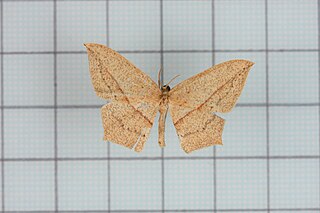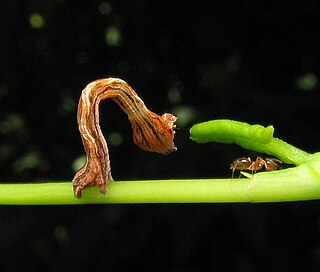
The geometer moths are moths belonging to the family Geometridae of the insect order Lepidoptera, the moths and butterflies. Their scientific name derives from the Ancient Greek geo γεω, and metron μέτρον "measure" in reference to the way their larvae, or inchworms, appear to measure the earth as they move along in a looping fashion. A very large family, it has around 23,000 species of moths described, and over 1400 species from six subfamilies indigenous to North America alone. A well-known member is the peppered moth, Biston betularia, which has been subject of numerous studies in population genetics. Several other geometer moths are notorious pests.

The blood-vein is a moth of the family Geometridae. The species was first described by Anton Schmidt in 1931.
Timandra is a minor planet orbiting the Sun that was discovered by American astronomer Joel Hastings Metcalf on February 16, 1906, in Taunton, Massachusetts.
In Greek mythology, Timandra was a Spartan princess and later on, queen of Arcadia.

Lais of Hyccara was a hetaira (courtesan) of Ancient Greece. She was probably born in Hyccara, Sicily and died in Thessaly. She was a contemporary of another courtesan with the same name, Lais of Corinth. Since ancient authors in their accounts often confused them or did not indicate which they refer to, the two have become inextricably linked.
In Greek mythology, Aegypius was a Thessalian son of Antheus and Bulis. He was the lover of Timandra, a widow.

Timandra is a genus of moths in the family Geometridae first described by Philogène Auguste Joseph Duponchel in 1829.

Timandra amaturaria, the cross-lined wave moth or cobra inchworm, is a species of moth of the family Geometridae. The species was first described by Francis Walker in 1866. It is found in the US from Massachusetts to Florida, west to Texas and north to Wisconsin.

Timandra extremaria is a species of moth of the family Geometridae first described by Francis Walker in 1861. It is found in Taiwan.

Timandrini is a tribe of geometer moths, with about 45 species in four genera. It was described by Stephens in 1850.

Elymnias nesaea, the tiger palmfly, is a butterfly in the family Nymphalidae.
Timandra was launched in 1814. She started trading with India and made one voyage for the British East India Company (EIC) before she was lost off the Lofoten Islands in 1822.
Timandra was launched in 1822. She sailed to India and South East Asia under a license from the British East India Company (EIC) before she disappeared in 1829.
A number of ships have been named Timandra for the mythological Timandra:

Timandra comptaria is a moth of the family Geometridae first described by Francis Walker in 1862. It is found in Sri Lanka, Japan and Taiwan.

Timandra Harkness is a British writer, presenter and comedian.
in Greek mythology, Timandra is a widow woman who became the lover of Aegypius.
In Greek mythology, Bulis is a minor figure who partook in accidental incest with her own son, Aegypius.
In Greek mythology, Neophron is a minor mythological character, who, in order to take revenge against Aegypius seducing his mother Timandra, seduced Aegypius's own mother Bulis. His myth is preserved in the works of Antoninus Liberalis.











